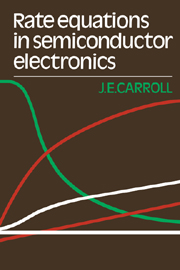Book contents
- Frontmatter
- Contents
- Preface
- 1 Introduction to rate equations
- 2 Elementary rate equations in semiconductors
- 3 Rates of switching
- 4 Rates of change and transfer in phase space
- 5 Rate equations in quantum electronics
- 6 Rate equations in optoelectronic devices
- 7 Advanced topics in rate equations
- Appendix A Counting states
- Appendix B Notes on differences between gas and diode laser rate equations
- Notes on solutions
- References
- Index
2 - Elementary rate equations in semiconductors
Published online by Cambridge University Press: 04 December 2009
- Frontmatter
- Contents
- Preface
- 1 Introduction to rate equations
- 2 Elementary rate equations in semiconductors
- 3 Rates of switching
- 4 Rates of change and transfer in phase space
- 5 Rate equations in quantum electronics
- 6 Rate equations in optoelectronic devices
- 7 Advanced topics in rate equations
- Appendix A Counting states
- Appendix B Notes on differences between gas and diode laser rate equations
- Notes on solutions
- References
- Index
Summary
Charge carrier transport
Introduction
The motion of charge carriers within a semiconductor is governed by a number of useful concepts which can be understood in straightforward ways from rates of change of particles in space, time, momentum and energy. In chapter 1 it was seen that the conservation of particles leads to the continuity equations (1.2.3) and (1.2.5) relating the rate of accumulation of charge density ∂ρ/∂t and the spatial rate of dispersal, div J, of current density J.
This section shows how rates of change of momentum and energy determine the velocity ν = J/ρ of charge carriers as the electric field changes within a semiconductor. In chapter 4 a more detailed approach to carrier transport is discussed using the Boltzmann collision equation, which brings in diffusion and also develops a model relevant to the Gunn effect.
The later sections of this present chapter continue with elementary transport discussing the rates at which semiconductors relax back to equilibrium. Chapter 3 outlines how such rates place limits on the engineering of devices for very high speed switching.
Rates of change of momentum: mobility
Quantum theory assures one that electrons behave as waves and that electron waves can travel freely through a perfectly periodic array of atoms such as is formed by a perfect crystal. The analogy is often made between electron quantum waves in a crystal and electromagnetic waves travelling through a periodic structure of inductors and capacitors. In such a filter only certain frequencies are permitted to propagate. In the crystal there is equally a limited range of frequencies for the quantum waves, and this means a limited range of energies for the mobile electrons (Fig. 2.1).
- Type
- Chapter
- Information
- Rate Equations in Semiconductor Electronics , pp. 16 - 32Publisher: Cambridge University PressPrint publication year: 1986

